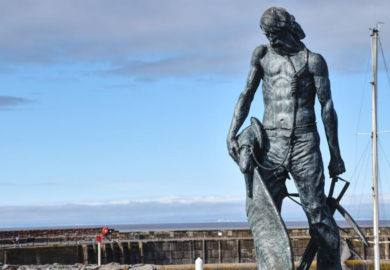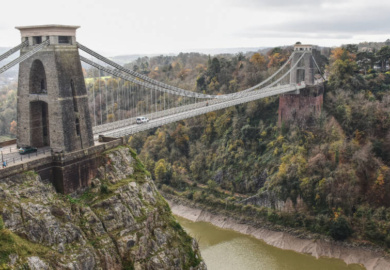The first time we visited Minehead, we had a pasty, a look around the town, and drove off. The second time, we walked from Watchet, took a couple of photos of Owen Ward’s wonderful sculpture marking the start of the South West Coast Path, had a coffee, jumped on a bus, and returned to Watchet for a glass of cider followed by fish and chips. The last time, we couldn’t just get there and virtually leave again as we arrived on the West Somerset Railway and had a return ticket. Within ten minutes, even though we planned on eating lunch in Minehead, we weren’t thrilled at the prospect of spending a couple of hours in the town. Minehead is one of the bookmarks of the steam railway, but it simply hasn’t got the charm for that role. The trouble with Minehead is it reminds me of the place I grew up. But that was as it was over forty years ago. To me, Minehead feels like it belongs in the past, but not in a historically appealing way.
I want to like Minehead, I really do. Every time we visit, I think, ‘give the town another chance.’ Yet within twenty minutes or so, I’m itching to leave. Why is that?

Cheap as Chips
The last visit threw more light on my problem with the place. Like I mentioned, the plan was to have lunch. A walk up one length of The Avenue and down the other, then up again revealed there were plenty of places to eat … if I wanted a pasty, fish and chips, burgers, kebabs, any number of fried things, meals beamed down from the 1980s. Any number of things I could find on the interchangeable main streets in any forgettable town in the UK. Cheap, cheerful, and hearty carb hits. Plenty of mainstream crowd-pleasers, but nothing particularly interesting, innovative, or different. Yet, one of the reasons I love living in Somerset is the choice of great places to eat, where I can enjoy the best of local produce as well as more creative offerings. From a gastronomically diverse point of view, Minehead is disappointing. In the end, we opted for the Galley restaurant at the Beach Hotel because the menu was just that wee bit more appealing than everywhere else. The dining room has an attractive contemporary marine vibe which suits its location and while all we ate were battered fillets of fish in a bun (The Codfather), they were, at least, at the lighter end of the fried food scale.

A blessing and a curse
Passing time, wandering around Minehead, we overhead students asking locals a set of questions relating to a project about whether Minehead being the location of the largest Butlins resort in Britain had a negative or positive impact on the town. This piqued my interest. It is a question that explodes in my head whenever I’m there because it quickly becomes evident the proximity of the resort shapes Minehead’s personality and has a dominating impact on the businesses on its streets. While pretending to peruse a menu, I listened to one articulate local woman’s response. She pointed out that Butlins brought people and therefore trade to the town. The presence of Butlins was to thank for there being a greater choice of supermarkets than anywhere else nearby. And, basically, without Butlins Minehead would be a ghost town.

All pertinent points, and ones I could apply to the days when my hometown of Rothesay was rammed with holidaymakers from Scotland’s Central Belt. It was a cheap and cheerful seaside resort with cafes, fish and chip shops, amusement arcades, gardens (Blenheim Gardens even reminds me of Rothesay’s Winter Gardens, but on a bigger scale), a beach, and a scenic location. Sound familiar? But in the late 1970s, the masses moved on to Blackpool and then Majorca and further afield. With all its eggs in the one tourist basket, Rothesay fell into a decline it is only recently starting to emerge from. While other islands offered a more unique Scottish experience which better suited the tastes of modern visitors, for a long, long time Rothesay remained shackled to its mass tourism memories and was unable to change. And that’s exactly what I see in Minehead.

The woman being interviewed remarked that without Butlins, nobody would have a reason to come. That view is a symptom of dependency syndrome. Why would anyone come? It’s where the West Somerset Railway ends. On a midweek day in late September, the train’s many carriages were packed. It’s also the start of the South West Coast Path, which is highly popular. And, as the Somerset Tourism website points out, it’s on the edge of Exmoor as well as being a short hop to the Quantocks. It is an area of outstanding beauty. Take a look at the places which surround Minehead – captivating Porlock/Porlock Weir on the other side of Bossington Hill. Watchet to the east. The medieval market town of Dunster just inland. All of them oozing bags of charm and individual identities which makes them magnets for visitors. Amid that enviable trio, Minehead feels like the anomaly. Ironically, the place I’m least likely to visit despite its potential charms.

Minehead currently caters for the market it has, and that’s fine. It makes sense. But, as my hometown discovered, tastes change. Have changed. Butlins once had nine resorts in Britain, now it has three. Minehead has more than one tourism market to, well, mine. It’s time it shifted at least some of its eggs into another basket.

